Artists have been working with the notion of space for centuries, pushing the limits with regard to what is possible in the sphere of spatial manipulation. The three contemporary artists we want to tell about today have been creating at the intersection of genres, mixing architecture and sculpture, interior and landscape design, fine art and installation art. And what they’ve reached with their endeavours to play with human’s perception of the three dimensions is close to magic.
Xavier Corbero
Corbero has lived in Barcelona for the bulk of his career and has even been awarded a St.George’s Cross for his contributions to Catalan art and culture. One look at Xavier’s resume confirms that the award was well deserved. He has an immense presence in the world of sculpture both in terms of the physical size of his sculptures and in reputation. His work can be found in a number of prominent cities around the world, including Barcelona, London, Kuwait City, Chicago, New York, and Santa Cruz de Tenerife.
Cobero’s sculpting prowess is contributed to by his unique vision regarding the role of space in his art. He suggests that “if you get the scale right, space stops being space to become mind.” The home that Cobero has spent 40 years building is arguably his greatest artistic achievement in terms of the manipulation of space. There are a few anecdotes which suggest that friends who visit Cobero often have to call him because the space inside his home has been used so differently that visitors become disoriented. It is a maze of dramatic arches and multiple whimsical structures built across 32 acres of land.


Sol LeWitt
Solomon LeWitt was a fascinating artist who loved to create conceptual art and then hand over the reins entirely to others to complete his projects. He frequently had his assistant’s construct 3D art that he referred to as “structures”. Some of his more renowned pieces include a 4-sided pyramid and his set-back skyscraper. LeWitt was motivated by a desire to create art that bypassed the physical need to determine what was or was not possible. He focussed on geometric shapes and quasi-logical systems and caused the viewer to double take to work out what was happening within the structure (in the event that the structure became anything more than a concept).
His cube-centric style is easy to recognize. It is clearly as much about manipulating the space and eye of the viewer, as about pushing the limits of the subjunctive.


Antony Gormley
Gormley is prolific in the sphere of sculpture. He discussed the nature of his relationship with space in a Ted Talk in 2012, stating that he realised as a child that space was a malleable concept. He humorously accounted his lifelong love of spatial manipulation to being forced to take afternoon naps as a child. In particular, he reminisces being forced into a “hot, dark, claustrophobic, matchbox-sized space” and how the space “would get bigger and darker and cooler” over time, until he ultimately came to enjoy his nap time.
Whilst this experience is something we could all relate to, what is extraordinary about Gormley is that he spend the rest of his life creating artwork which allows the viewer to witness the malleability of space. His work includes creating an Amazonian field made up of approximately 24,000 terracotta pieces and an eerie installation called domain field which is made up of human shaped figures apparently floating through an undefinable space. Each work of art causes the viewer to query what is it that they are seeing: the pieces that work together don’t seem to fit with the space that they are taking up.










